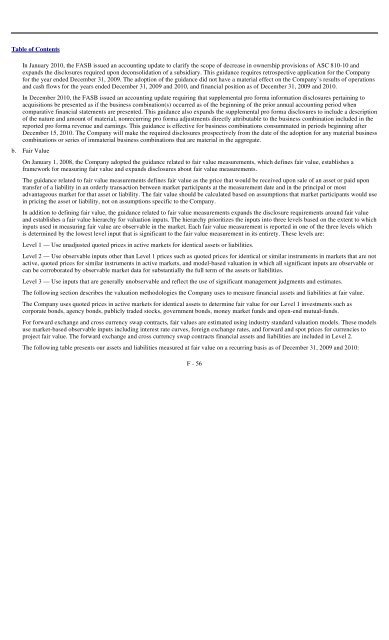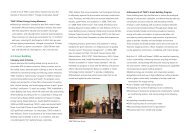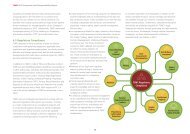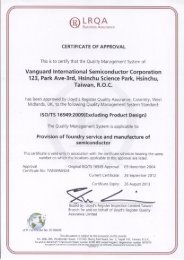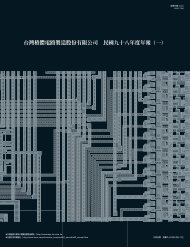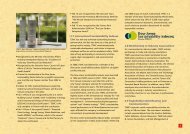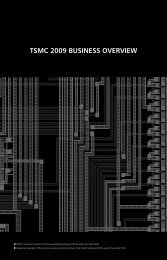Form 20-F Filings with U.S. SEC (4/15/2011) - TSMC
Form 20-F Filings with U.S. SEC (4/15/2011) - TSMC
Form 20-F Filings with U.S. SEC (4/15/2011) - TSMC
- No tags were found...
You also want an ePaper? Increase the reach of your titles
YUMPU automatically turns print PDFs into web optimized ePapers that Google loves.
Table of Contents<br />
In January <strong>20</strong>10, the FASB issued an accounting update to clarify the scope of decrease in ownership provisions of ASC 810-10 and<br />
expands the disclosures required upon deconsolidation of a subsidiary. This guidance requires retrospective application for the Company<br />
for the year ended December 31, <strong>20</strong>09. The adoption of the guidance did not have a material effect on the Company’s results of operations<br />
and cash flows for the years ended December 31, <strong>20</strong>09 and <strong>20</strong>10, and financial position as of December 31, <strong>20</strong>09 and <strong>20</strong>10.<br />
In December <strong>20</strong>10, the FASB issued an accounting update requiring that supplemental pro forma information disclosures pertaining to<br />
acquisitions be presented as if the business combination(s) occurred as of the beginning of the prior annual accounting period when<br />
comparative financial statements are presented. This guidance also expands the supplemental pro forma disclosures to include a description<br />
of the nature and amount of material, nonrecurring pro forma adjustments directly attributable to the business combination included in the<br />
reported pro forma revenue and earnings. This guidance is effective for business combinations consummated in periods beginning after<br />
December <strong>15</strong>, <strong>20</strong>10. The Company will make the required disclosures prospectively from the date of the adoption for any material business<br />
combinations or series of immaterial business combinations that are material in the aggregate.<br />
b. Fair Value<br />
On January 1, <strong>20</strong>08, the Company adopted the guidance related to fair value measurements, which defines fair value, establishes a<br />
framework for measuring fair value and expands disclosures about fair value measurements.<br />
The guidance related to fair value measurements defines fair value as the price that would be received upon sale of an asset or paid upon<br />
transfer of a liability in an orderly transaction between market participants at the measurement date and in the principal or most<br />
advantageous market for that asset or liability. The fair value should be calculated based on assumptions that market participants would use<br />
in pricing the asset or liability, not on assumptions specific to the Company.<br />
In addition to defining fair value, the guidance related to fair value measurements expands the disclosure requirements around fair value<br />
and establishes a fair value hierarchy for valuation inputs. The hierarchy prioritizes the inputs into three levels based on the extent to which<br />
inputs used in measuring fair value are observable in the market. Each fair value measurement is reported in one of the three levels which<br />
is determined by the lowest level input that is significant to the fair value measurement in its entirety. These levels are:<br />
Level 1 — Use unadjusted quoted prices in active markets for identical assets or liabilities.<br />
Level 2 — Use observable inputs other than Level 1 prices such as quoted prices for identical or similar instruments in markets that are not<br />
active, quoted prices for similar instruments in active markets, and model-based valuation in which all significant inputs are observable or<br />
can be corroborated by observable market data for substantially the full term of the assets or liabilities.<br />
Level 3 — Use inputs that are generally unobservable and reflect the use of significant management judgments and estimates.<br />
The following section describes the valuation methodologies the Company uses to measure financial assets and liabilities at fair value.<br />
The Company uses quoted prices in active markets for identical assets to determine fair value for our Level 1 investments such as<br />
corporate bonds, agency bonds, publicly traded stocks, government bonds, money market funds and open-end mutual-funds.<br />
For forward exchange and cross currency swap contracts, fair values are estimated using industry standard valuation models. These models<br />
use market-based observable inputs including interest rate curves, foreign exchange rates, and forward and spot prices for currencies to<br />
project fair value. The forward exchange and cross currency swap contracts financial assets and liabilities are included in Level 2.<br />
The following table presents our assets and liabilities measured at fair value on a recurring basis as of December 31, <strong>20</strong>09 and <strong>20</strong>10:<br />
F - 56


